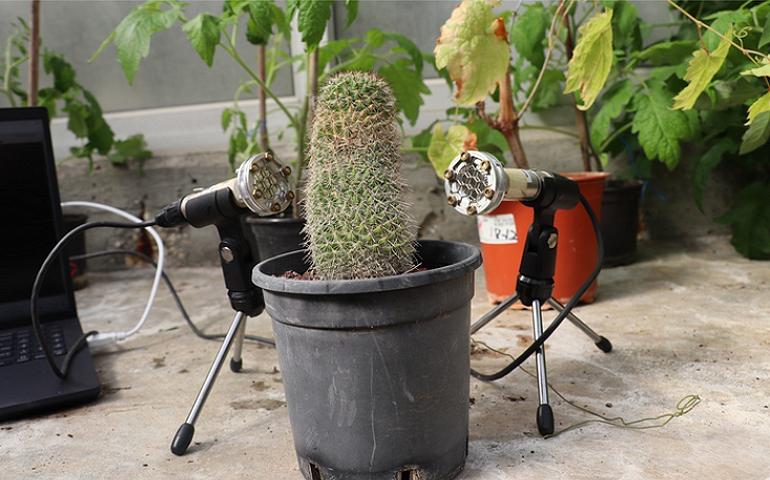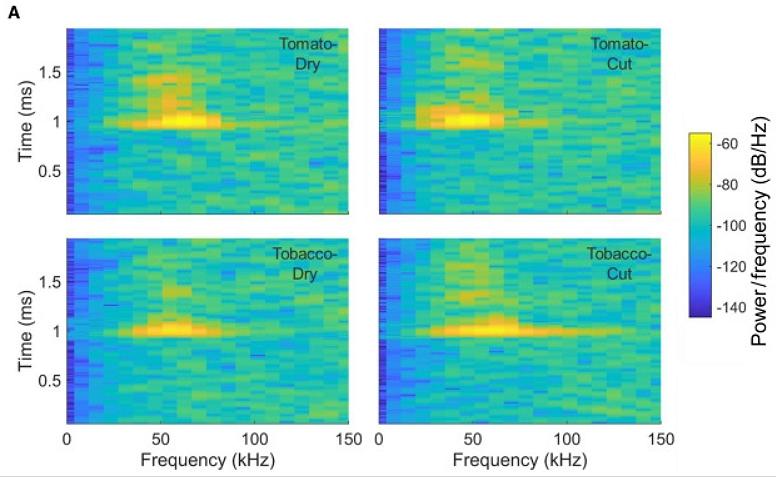The Plant Kingdom Is Not Silent: We Just Can’t Hear It

TEL AVIV, Israel, March 31, 2023 (Maximpact.com Sustainability News) – Plants are not silent as most people believe, but the sounds they make are ultrasonic, too low for the hearing range of the human ear, new research demonstrates. “An idyllic field of flowers can be a rather noisy place. It’s just that we can’t hear the sounds!” Professor Lilach Hadany from Tel Aviv University said with a smile, as the landmark research on plants she led was published this week in the peer-reviewed journal “Cell.”
“In this study we resolved a very old scientific controversy,” Hadany said. “We proved that plants do emit sounds!
“Our findings suggest that the world around us is full of plant sounds, and that these sounds contain information – for example about water scarcity or injury. We assume that in nature the sounds emitted by plants are detected by creatures nearby, such as bats, rodents, various insects, and possibly also other plants – that can hear the high frequencies and derive relevant information,” she said.
Pressor Hadany suggests that humans can also use the acoustic information that plants emit, given the right tools “such as sensors that tell growers when plants need watering.”
The Tel Aviv University scientists have recorded and analyzed sounds distinctly emitted by plants,” in research they are calling a global breakthrough.. They say that “the click-like sounds, similar to the popping of popcorn, are emitted at a volume similar to human speech, but at high frequencies, beyond the hearing range of the human ear.”

“We found that plants usually emit sounds when they are under stress, and that each plant and each type of stress is associated with a specific identifiable sound,” the researchers explained in their paper <https://doi.org/10.1016/j.cell.2023.03.009>. “While imperceptible to the human ear, the sounds emitted by plants can probably be heard by various animals, such as bats, mice, and insects.”
To watch the research video, click here: https://www.youtube.com/watch?v=hOWaXi0I2YE
A mathmatician, Professor Hadany is from the School of Plant Sciences and Food Security at the Wise Faculty of Life Sciences, and she was lead scientist on the study, together with Professor Yossi Yovel, who heads the Sagol School of Neuroscience and serves as a faculty member at the School of Zoology and the Steinhardt Museum of Natural History.
They were working with research students Itzhak Khait and Ohad Lewin-Epstein, in collaboration with researchers from the Raymond and Beverly Sackler School of Mathematical Sciences, the Institute for Cereal Crops Research, and the Sagol School of Neuroscience – all at Tel Aviv University.
Their findings are confirmed by the expert gardeners at Pistils Nursery in the city of Portland, Oregon.
“Sound waves stimulate the plant’s cells. When the cells are stimulated by the sound, nutrients are encouraged to move throughout the plant body, promoting new growth and strengthening their immune systems,” Pistils explains on its website <https://pistilsnursery.com>.
A review of past scientific writing on how plants respond to sound starting with “The Secret Life of Plants” by Peter Tompkins in 1973, shows that plants respond to music and even have a specific taste in music. Some kinds of music promote growth and others can be damaging.
The Pistils gardeners write, “Roses in particular seem to love violin music. For most plants playing classical or jazz music caused growth to increase, while harsher metal music induced stress. This may be because the vibrations of metal music are too intense for plants and stimulate cells a little too much.
“We think of this like massaging your plant with a song – they prefer a gentler touch.”
What Botanists Have to Say
Devendra Vanol of the Institute of Integrated Study and Research in Biotechnology and Allied Sciences in India found that not only does music promote plant growth, but it seems that plants can actually distinguish between different types of sound including different genres of music, nature sounds, and traffic noise. Vanol and her team say it could be advantageous for plants to distinguish sounds to learn about their surrounding environment.
Reda Hassanien of China Agricultural University in Beijing says that sound waves “significantly increased the yield of sweet pepper, cucumber, tomato, spinach, cotton, rice, and wheat. Additionally, pests such as spider mites, aphids, gray mold, late blight, and virus diseases of tomatoes decreased in greenhouse conditions with sound treatment. It is amazing what plants can do with a little bit of music playing in the greenhouse!”
That’s plants responding. What’s new about the Tel Aviv University research is that it showed that plants actually generate sounds.
How the Breakthrough was Made
Prof. Hadany dug down deep to explain her research. “From previous studies we know that vibrometers attached to plants record vibrations. But do these vibrations also become airborne soundwaves – namely sounds that can be recorded from a distance? Our study addressed this question, which researchers have been debating for many years.”
At the first stage of the study the researchers placed plants in an acoustic box in a quiet, isolated basement with no background noise. The study focused mainly on tomato and tobacco plants, but wheat, corn, cactus and henbit were also recorded.
Professor Hadany said, “Before placing the plants in the acoustic box we subjected them to various treatments: some plants had not been watered for five days, in some the stem had been cut, and some were untouched. Our intention was to test whether the plants emit sounds, and whether these sounds are affected in any way by the plant’s condition.”
“Our recordings indicated that the plants in our experiment emitted sounds at frequencies of 40-80 kilohertz,” Hadany said. This range is the low end of human hearing. The bottom half of this range – 20 Hz to 40 Hz – is more felt than heard.
“Unstressed plants emitted less than one sound per hour, on average, while the stressed plants – both dehydrated and injured – emitted dozens of sounds every hour,” Hadany said.
The research group used artificial intelligence to analyze the sounds that were recorded.
“The recordings collected in this way were analyzed by specially developed machine learning (AI) algorithms. The algorithms learned how to distinguish between different plants and different types of sounds, and were ultimately able to identify the plant and determine the type and level of stress from the recordings,” Hadany reported.
“Moreover, the algorithms identified and classified plant sounds even when the plants were placed in a greenhouse with a great deal of background noise. In the greenhouse the researchers monitored plants subjected to a process of dehydration over time and found that the quantity of sounds they emitted increased up to a certain peak, and then diminished,” she said.
In the study, which is open to public access in “Cell,” the researchers write, “Here we show that plants indeed emit airborne sounds, which can be detected from several meters away, both in acoustic chambers and in greenhouses. Moreover, we show that the emitted sounds carry information about the physiological state of the plant.”
“We succeeded in differentiating between sounds emitted under two different stress conditions – dry and cut plants – with an accuracy of 70% using supervised machine learning methods, and distinguishing between drought-stressed and control plants in a greenhouse, based only on the sounds they emit.”
“By training machine learning models, we were able to distinguish between drought-stressed, cut, and control plants, based only on the sounds they emit.”
The authors suggest that the study of plant sounds will be important for efficiency in agriculture, writing, “These results demonstrate the potential in studying plant bioacoustics, suggest that plant acoustic emissions may play an important role in ecology and evolution, and may have direct implications for plant monitoring in agriculture.”